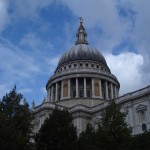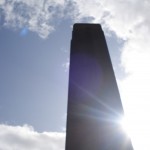September 15th, 2009 · No Comments
-
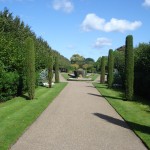
-
Regents Park
-
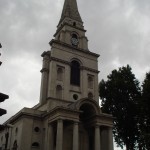
-
Christ’s Church
-
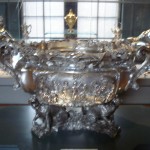
-
The Silver Exhibit in the V&A
-
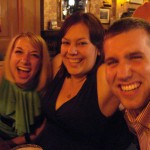
-
Having a Good Time at the Fitzroy
Like many of my classmates I decided it would be worthwhile to summarize all of my discoveries this month in London. During this post I will focus on six main themes found within London: Parks, Churches, Pubs, Other Religious Institutions, Theatre and Museums.
Parks
Each park that I visited had its own distinct characteristics that separated it from any other. Green Park was the first I visited and after perusing a few others, I realized there was nothing that exciting about it. Located right across from Buckingham Palace, Green Park certainly provides a good place to go and take a break from the busy atmosphere of the area. Besides this however there is not much going on and I would recommend that potential park goers walk the extra distance over to St. James Park.
In addition to the large number of waterfowl heckling people for food which offers consistent entertainment St. James offers some picturesque flower beds throughout and various monuments along the way. It has the relaxing atmosphere of Green Park with a bit more excitement sprinkled in.
Regents Park offers a completely different feel from Green or St. James. Located in a separate area of London, Regents Park has a history of being used by a higher end crowd. I could tell this immediately from the feel of the park. The decorative shrubbery and elegant architecture throughout gave me a feeling that Regents is not as well used as other parks.
Since I was one of the members of the Parks group that gave a walking tour of Hyde Park and Kensington Gardens I could go into a lot more detail about these two green spaces but I will choose not to in an effort to be concise. In summary Hyde Park is the largest green space in London and is often used for larger events such as concerts, festivals etc. It also contains a large number of monuments throughout including the 7/7 memorial and the Diana Memorial Fountain. Kensington Gardens is home to a variety of key monuments but is not as well trodden as Hyde. Overall it makes for a quieter atmosphere, more conducive fo reading or “snogging”.
Regents Park were my two favorite green spaces in London. Regents, is both beautiful, and extremely large and I continually felt the need to go back and explore. Kensington Gardens appealed to me in that it was quainter than Hyde Park but contained a like amount of history and monuments throughout. Although I would be content spending a length of time in any London green space Regents and Kensington would be my top choices.
Theatre
Overall I enjoyed going to the theatre on so many occasions. What better place to do so than in London after all? Here I will discuss my favorite performances and theatre venues.
All in all I enjoyed all but two of the performances we saw. The two Shakespeare productions at The Globe Theatre were fantastic. Although I did not particularly enjoy reading Troilus and Cressida it made a huge difference to be there so close to the actors. The fantastic drum chorus at the end really sealed the deal. As You Like It was probably my favorite show I saw here in London. Although it is one of Shakespeare’s simpler plays the actors really made it jump off the page. Being down it the pit was fantastic because of all the ad-libbing and constant interaction with the crowd. I even felt traces of Touchstone’s saliva on my arm at one point.
The other Shakespeare performance I saw, All’s Well That Ends Well, was lackluster. Although the Olivier was my favorite performing venue (this is what an auditorium style theatre should be like…why can’t Dickinson have something like this?) the play itself was odd and ended on an abrupt and odd note.
The other play we saw at the National Theatre, The Pitmen Painters, was fantastic. Although I was dozing a bit because of the Benadryl I took right before the show, the actors kept my attention and I appreciated that the play was based off of a true story.
Easily the oddest play we saw was Arcadia. An extremely intelligent performance the play juxtaposed two different periods in time and created a singular storyline in which the plot was based. Overall it was an entertaining performance that made me think early and often.
Finally there was Blood Brothers. The lone musical I saw produced feelings of disbelief, anguish and held back laughter. The ridiculous 80’s sound track and creepy narrator just didn’t do it for me. I think it’s safe to say that I was not the only one from Humanities 309 who was a bit surprised to see just about everyone in the audience give it a standing ovation.
I had a very positive experience with the theatre here. I would go back to the globe again and again. I loved being that close to the action. I would also enjoy seeing another show in the Olivier. There really is so much to choose from here. It’s simply a matter of figuring out your tastes and saving your money so you can see a lot of performances.
Churches
From Westminster Abbey to St. Paul’s Cathedral we saw most of the major churches/cathedrals during our month in London. St. Paul’s was easily my favorite. From the fantastic crypt to the hundreds of stairs up to the tower it had so much to offer in the way of history and mystique. Westminster Abbey fascinated me primarily because of all the literary figures that had been buried inside as well as the room that was dedicated to “The Order of the Bath”. Other churches that I really enjoyed taking a look at were: “St. Martin in the Fields” which sits just outside Trafalgar Square and Nicholas Hawkesmoore’s “Christ’s Church” which is located in very close proximity to Brick Lane.
Other Religious Institutions
Overall the Sikh Gurdwara was my favorite place that we visited. I appreciated the simplicity of the religious doctrine as well as the conviction and honesty with which our tour guide, Mr. Singh spoke. The morning was capped off with a fantastic sit down meal together in which everyone was served the same food and drink.
I had different feelings about the Hindu Mandir. It was clear to me from the very beginning that the Hindu religion is not nearly as modest as Sikhism nor are they trying to be. From the extremely decorative prayer room, to the museum located right in the center of the Mandir I never felt particularly comfortable inside.
The only religious institution I wish we had gotten a chance to visit is a Mosque. I had been to one many years ago but I did not remember a whole lot from my experience. I wonder how much more lively the East End, and all parts of London would be if Ramadan were not taking place during our time here.
Museums
I could go on and on about museums so I will attempt to stay as concise as possible.
The British Museum was massive, convenient since it was so close to the Arran House but a little one dimensional at times. One of my favorite exhibits at the British Museum was a special exhibit on Living and Dying that drew information from all different time periods and cultures.
The National Gallery was fantastic. Although I have a hard time appreciating some visual art the gallery kept my attention for a number of hours. Seeing so many famous works of art was phenomenal.
The Tate Modern was my least favorite museum here. Although I am trying I have a hard time understanding modern art. After about 45 minutes in this museum it ended up being too much for me.
The Cabinet War Rooms/Churchill Museum were two of my favorites. The realization that I was standing in one of the most important places in World War II history was unbelievable. The War Rooms felt so authentic. I really felt as though I had been taken back in time to the 1940’s while inside.
The Victoria and Albert was easily my favorite museum in London. There was so much variety inside and so much to see. I could have easily spent a few days inside. Two of my favorite exhibits were the silver and jewelry exhibits. I’m not sure what this says about me as a person but I found it unbelievable that individuals could even own such treasures. I also enjoyed the laid back atmosphere of the V&A staff. At most of the other museums I visited I felt like I was doing them a disservice simply by being there. Although I understand that taking pictures of an object in a museum doesn’t do it justice I like to be able to have the option of doing so.
The Sir John Soane museum interested me but it wasn’t really my cup of tea in the end. It also had a stuffy atmosphere to it that I didn’t really appreciate.
One thing I can draw from my experience at museums here is that each and every one has something that distinguishes it. With so many museums I thought that it would be impossible to avoid some overlap but I never really felt that. Cheers to London and its museums.
Pubs
Finally we have pubs. What would London be without it’s public houses? In some cases pubs are the true museums of London, designating what an area was like in the past and what type of clientele it attracted. During my month here I had a chance to visit a few pubs and get a general sense of what some possible differences could be. It is clear to me that each pub brings something different and unique to the table. The Marlborough Arms was convenient being so close to the Arran House and was a great place to enjoy a pint over a meal with friends. The Court was conducive to socializing in a different way. The music was louder, the people louder and the drinks cheaper. Other places I visited offered other things that made them stand out as well. One thing that i’ve learned about pubs is that it’s hard for one to please everyone. Since everyone has different tastes and desires when it comes to pubs you are better off going to one with a small cohesive group.
To conclude this novel I would just like to say that I think we saw a lot of different faces of London this month. I realize there is much more to see here but between walking tours throughout the city, trips to major monuments and museums and individual exploration I have learned a ton about London, it’s history and where it is going. I look forward to more London explorations in the future but for now, ON TO NORWICH!
Tags: Churches and Cathedrals · Henry · Pubs · Theatre
September 14th, 2009 · 1 Comment
Today Sarah and Alli ventured into the Cabinet War Rooms and the Churchill Museum. From remarks from our classmates, we thought it would be a quick trip through, but it most certainly was not! The museum was packed full of video footage, interactive exhibits, artifacts, and sheer information. For us to fully read and thoroughly explore the place, it probably would have taken us about 3 hours. Since it was the most interactive and technology-based of all the museums we had gone to in London, we would like to further discuss the use of these ideas.
Both of us have worked with museums and exhibits this summer, so neither of us can help it but to look at exhibits with a more critical eye. The Churchill Museum, only just recently opened in February 2005, relies on its “cutting-edge technology and multimedia displays” to bring Churchill’s story to life. The displays include a 15 metre-long interactive lifeline that, by sliding your fingertips along a strip, you can access information from every year of Churchill’s life.We felt the most effective interactive display was a touch-screen poll that initally asked the guest’s opinion on a certain aspect of Churchill’s life, such as “Do you think Churchill was a good wartime leader?” You were then offered more information on your topic and then reasked the question to see if your opinion changed.
We then thought about the importance of technology in museums and what it has added to the visitor experience. Technology has improved museum exhibitions in many ways: visitors can access historical documents, watch video footage, play “educational games” to learn information, and the museum is able to house much more materials through databases than they could before. It also allows visitors to choose whether they would like to view more information or “do research” or they can decide to move on. In this way, the experience is much more “tailor-made” for the visitor, allowing them to explore their own interests.T
The use of technology comes at a price. First of all, many museums do not even have the funding to afford such displays set up, even though it would benefit them greatly. Many museums, whether they are being rennovated or newly opened, are almost expected to have some sort of technology involved. Also, as we all know too well, the use of technology often comes with glitches and is susceptible to malfunctioning. The 15 metre interactive timeline was a great idea, but we could not really figure out how to use it! For two 20 year-olds who grew up using technology, we can’t even imagine older folks trying to figure out some of these displays.
Overall the technology benefitted our experiences in the Churchill Museum. We noticed most of the visitors engaged with the interactive media and we learned a whole lot more than we expected to. However, museums need to carefully evaluate their reliance on technology-based exhibits. The ideal exhibit would be a balance of both the traditional artifact-based model with some elements of technology to enhance the objects and the concepts presented.
Tags: Alli · Sarah
Hey there, Patsy and Amanda Girl here, your one and only source into the the scandalous lives of Londons elite,
(aka Dickinson college Norwich Humanities students)
In the last few days we have made quite the dent in our list of required activities. Instead of blogging after each trip, we decided to collaborate our ideas and opinions within in one “museum” post.
At this particular time we have gone to both the British Museum and the Cabinet War Rooms/ Churchill Museum. What we would like to do, is continue to add information about required museums to this post during the remainder of our time in London.
Although Amanda cheated and already wrote about the British Museum, we will further our analysis of this great house of stolen goods in this post. After a morning of strolling over eroding bodies, we found a glorious pizza joint and indulged ourselves with BBQ chicken pizza and a meaty calzone. Realizing we ate our body weight in food, we decided to return the Bloomsburry area to change for the gym. Needless to say our intentions were not strictly academic so, to get back on track, we agreed to visit the British Museum before our workout.
Our first impressions of the museum held true to Professor Qualls’s notion that to see everything would take a full day. After searching for a map, we began our search through the main level. In order to refrain from repeating what everyone has already written about this museum we have decided to note only our specific interests. We found that our two favorite exhibits were the table displaying rows and rows of pills, and the Greek Parthenon. Our initial thought was that the British were very lucky to have such precious and historical artifacts for any average person to view. However, after walking through each room, we realized that a such an extensive collection, from all over the world did in fact represent how powerful the British empire was. Are we ones to judge how these artifacts came into the possession of Britian ? We don’t think so, but it is fascinating to attempt to understand England’s direct relationship with countless foreign countries.
This is a perfect transition to our visit to the Cabinet War Rooms and the Churchill Museum. Before we entered the museum, we happened to stumble upon the traditional changing of the guards ceremony. Lets just say we became mildly afraid of fancy uniforms, big horses, and yelling. After our wild encounter with the guards, and a few stops to admire our surroundings, we walked over to the museum. We paid our admission fee and began our journey through this underground world. We were very impressed by the museums state, and became intrigued by the history of the Blitz, (luckily the next day we were informed by our class in Regent Park). We came to an exit, feeling mildly unimpressed with how short it was, and then realized we hadn’t seen the Churchill Museum. We then ventured upstream back to the museum.
The Churchill Museum is exactly that, a memorial museum to Winston Churchill that, depending on you attention span, can captivate you for quite a while. We both agreed that the overall construction of the museum was one of its most appealing characteristics. Its shape, lighting, and interactive activities provide entertainment for a wide age range. We were most amused by the time line in the center of the room that, when touched, displayed data from days of Churchill’s life.
Although these two museums, for the most part, have absolutely nothing in common, they both demonstrate critical and influential aspects of British history. Each museum we visit solidifies the idea that Britain is always evolving. Not only its people, but its ideas as beliefs as well.
By the way, the Gym down the street, Oasis, is not a gym! We were dressed and ready but it was nothing. Disappointed?
Some things never change, London better love us.
xoxo
Patsy and Amanda Girl
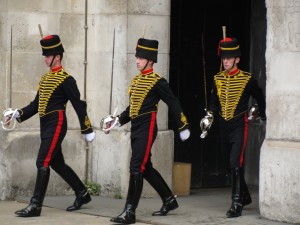
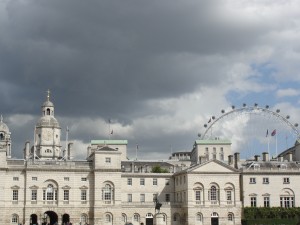
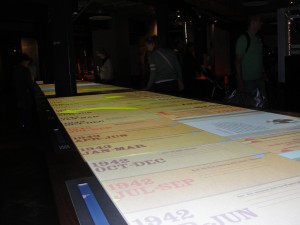
Tags: Amanda · Patsy
As I continue to explore London more and more I realize just how vast and widespread this place is. Before our class took a walk through Southwark on Friday morning I realized I had not even been close to where we were that day. There is so much to do here and it would take years and years to truly get a sense of what all London has to offer. Over the past few days i’ve been trying to conquer as much as London as possible. During Friday and Saturday I spent most of my time conquering museums and theaters.
I’ll start with museums. On Friday after our walk of Southwark I headed out to lunch with a fairly large group of people. After our lunch I had a hard time shaking off a bout of sudden tiredness. I figured a trip to the Tate Modern would remedy this. I’m not afraid to admit that I was wrong.
Modern art is an interesting beast. As much as I’ve tried still I have a hard time understanding it. Despite this statement in no way am I critical or judgemental of anyones work. As someone who has basically no experience/background with modern art I have no right to say anything negative about someone’s art, I simply just can’t grasp it. Walking around through the first few galleries of the Tate Modern I wandered, I sat, I stared, but still found nothing. I asked Brandon his opinion about some of the artwork and this helped. Talking to someone who has taken classes in the subject and is passionate about it was definitely a good choice and I learned a lot but after some more musings I still found nothing. Perhaps it was the drowsiness, perhaps it was the absurdly sexually explicit video I witnessed in one section of the museum but soon after entering I realized I had seen enough of the Tate Modern.
Since many other people in our class had seen the Cabinet War Rooms and the Churchill Museum earlier in the week I figured the afternoon would be a great time to see both of those. This time I was right. From the moment I entered the doors I had a feeling I would enjoy walking through this dungeon of secrets. Although I would never want to be stuck down there for long periods of time I was amazed at how well intact the war rooms were. As I walked through the narrow hallways I had an eerie feeling that I was sent back in time to the early 1940’s when Churchill used the space frequently during the Blitz to hold meetings and conduct secret business. My favorite part of the war rooms was the tiny room that Churchill put 11 secretaries in. According to the audio tour despite the close proximity to each other he expected immaculate work from every single one of these women and did not hesitate to fire them if they were not pulling their weight.
After the tour of the War Rooms I spent a bit of time in the Churchill museum before my fatigue caught back up to me. I decided it would behoove me to head back to my room and rest for a little bit before preparing for the performance of “Troilus and Cressida” that we would be attending that night at the Globe Theatre.
After getting off at the St. Paul’s tube stop and scurrying across the Millennium Bridge Brandon, Aidan and I made it to the performance about ten minutes early. Just enough time to catch our breath and prepare for the real ordeal: standing for three hours. Despite my concerns going into the performance in retrospect being a “groundling” was not that bad at all. My feet were certainly a little uncomfortable by the end of the night but being so close to the action on the stage certainly made up for that. I really enjoyed the performance overall. Matthew Kelly’s portrayal of Pandarus was phenomenal and Paul Hunter (Thersites) left me in stitches for most of the night. While reading the play beforehand I did not enjoy it all that much. It’s amazing how easily and completely transformed a play can become however once performed versus just read. My experience at the globe was great and I hope to go back and see another show before I leave London.
Walking back over the Millennium Bridge that night to the beautiful view of St. Paul’s across the Thames I concluded a few things. The first being that London is even more stunning at night than it is during the day. The second being that i’m not going to enjoy everything I see here in this city and I have to come to terms with that. I have been lucky so far on this trip that very few things have disappointed me. I realize I have to be ready to be surprised both negatively and positively with encounters I have, places I go and things I learn. Like everything else in life London is not perfect nor should it be.
Tags: Henry · Museums · Theatre
This was initially a comment on Audrey’s wall, but I realized I hadn’t written my own blog post yet, and (more importantly) I was getting a bit preachy. So here it is:
I would first like to say that a city devoted to capitalistic endeavors is a beautiful thing. I look around and everywhere I see touristy traps– places trying to make you pay for restaurant seats and churches. Bath was no different, save for its own self recognition. It didn’t try to be anything it wasn’t. You want to drink our fancy water, you bet your ass you’re paying money. So hats off to you Bath and your unashamed stance, don’t ever apologize!
I, like Audrey and fellow travelers, tried to find the quintessential “Bath.” Far beyond the wrenching grasp of the tourist industry. I wasn’t looking for anything beautiful though, on the contrary. I attempted to walk to streets further into the realm of residential. I found parks with no names, pubs with local patrons drinking at 2 in the afternoon, and shady alleyways with no pretty walls or paintings of any kinds. It was no landscape shot, but there was a beauty in the simplicity. Sadly, I had no idea how to get home and wondered aimlessly for quite a while until like a beacon of hope I ran into Professor Qualls, who told me I was only a turn away from the church (I swear I had been wondering for a long time).
My love of Celtic heritage made going to Stonehenge cool. I mean the curiosity of the whole thing was pretty cool, especially seeing how the English lady on the head set phrased their speculation on its purpose. Honestly, I thought they weren’t very culturally relative: they kept applying a few modern ideas to the potential purpose. The thought that Stonehenge would be a symbol of power with other purpose seems a bit silly. Further, they kept bringing up concepts of hierarchy, which is complete speculation. Anyway
Next big thing was Borough Market, which was incredible. I have found my new love, sorry Planet Organic. How busy and hectic it was. The mushroom dip was especially delicious. Anything from Kangaroo burgers to a bottle of red wine can be found there.
I can’t exactly remember chronological order, but we saw Troilus and Cressida at the Globe Theatre, and I was quite happy with it. I felt they leaned a little too hard on the comedy side, but I was in a strange mood when I read the play initially. All the actors were fantastic and the visual aspects of the people were quite engaging. It is always interesting to read works based around the Trojan War. I remember when I was but a wee-lad, and my grandmother read the Illiad to me, thinking how amazing Achilles was and not really caring about Hector too much, but as I matured and read the work again by myself I began to sympathize more and more with him and less so with Achilles, which I think is the idea. Both warriors are bound by a sense of honor and fate. After watching this preformance, I felt that Hector was almost more enslaved to his sense of duty than Achilles was to his pride.
The British Museum was pretty cool, and I think I finally get what everyone else has been feeling. When I was at the National Art Gallery, Paul stopped me to point out Sunflowers, by Van Gough, and I wasn’t really sure what to say. Cool? But when I was at the British Museum, I came across something called the Dancing Shiva (http://dustysojourner.files.wordpress.com/2009/06/shiva_nataraja_musee_guimet_25971.jpg). Last semester I had been one tequilla shot away from having the thing on my back (which doesn’t always mean it has any value to one at all but in this case it did). I’m not sure why, but it’s a symbol I have always connected with. The Nataraja is meant to represent the destruction of the universe through Shiva’s crazy dance moves, but it is also meant to show the oneness of the universe. So there I was, standing in front of this bronze statue feeling as giddy as a little school girl, awesome.
The Cabinet War Rooms and the Churchill Museum. What to say? The Brits love their Churchill. One of the first lines in the head set was something along the lines of Hitler and Churchill both had a cabinet, but Churchill never overroad his. Why bring Hitler into this? The other thing that made me chuckle was when they were retelling the story about the hole punch. Churchill basically chews out this secretary because he uses weird words and she couldn’t figure out what he meant, and then the head set said: but he had a lot of pressure, so it’s ok. Not ok Churchill, not okay. Overall, the museum was a giant pat on the back for the Brits and their ability to live in small rooms for a long time. Seeing where they lived was neat, but it wasn’t incredibly informative and despite having creepy wax figures and listening to recordings, I never felt enveloped in the way, I think, they wanted to make the guests feel.
As a note, make sure you ask the ticket guy for a receipt because they don’t give you one otherwise, and there is no way to be refunded without it– your ticket isn’t enough, and the museum isn’t worth the ten quid.
Anyway, cheers
Tags: Andrew R
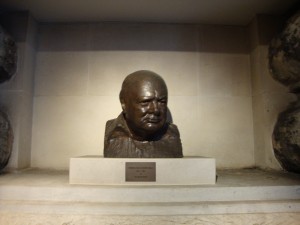
Churchill Bust
Today I visited both the Cabinet War Rooms/Churchill Museum and the Sir John Soane Museum and what struck me most about both of these very different museums was their presentation. The approach that these two museums took with presentation are very different from each other, and therefore striking in different ways. Having put on an exhibition myself during the past school year, I know the decisions involved in creating a show.
Although I visited both the Cabinet War Rooms and the Churchill Museum, I was much more impressed with the set up of the Churchill Museum, so that will be my focus here. Upon entering the Churchill Museum, the first thing I noticed was the color scheme: blue and grey/silver. This was continued throughout the exhibition which gave it cohesion and unity. This exhibit also mainly used interactive media like audio and video. My favorite section of the museum was the wall of black and white photos (keeping with the color scheme of the museum) that were back lit and place in deep silver frames. As you walked along the line of photos, motion sensors on the floor active clips from Churchill speeches that related to the photos. I found this combination of visual and audio stimulation to be very engaging.
Besides the color scheme, I also loved the various either lit up, scrolling, or painted Churchill quotes throughout the exhibition. Often when people picture art exhibitions they picture paintings and history exhibitions they picture photographs and artifacts. Adding text was just another way this exhibition engaged the audience successfully. As an English major and art minor, I found the quotes pleasing both because they were well chosen for their content, and also because they were presented in a very aesthetically pleasing way.
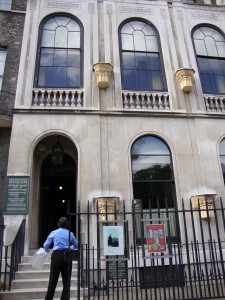
The Sir John Soane
The Soane Museum, on the other hand, had an equally engaging yet completely different layout. As opposed to the open, spacious, unified by color Churchill exhibit, the Sir John Soane Museum was in Soane’s home with tiny hallways, narrow stairwells, and rooms packed with busts and statues. Unfortunately no photographs were allowed in the museum, and only a photo could really convey the feeling of the museum—or home. That was the thing, this was the architect Sir John Soane’s home, more or less just the way he left it. The walls were covered in paintings and relief sculptures from various time periods. The banisters, tables, and other available wall space was covered in busts and other types of statues. Every windowsill and flat surface had something on it. The bookshelves were packed and the floors were all lined with various floral printed rugs. There was literally just enough room for a person to walk around the room or through the hallway. As I entered I had to place all my carried belongings in a plastic bag to be carried in front of me because there was not room enough for me to hold things at my sides as I walked. The stairwells winded around and as I walked, with my head always facing upward, I could not help but to think about the kind of man who would collect and appreciate these works of art, let alone live crammed in a house with them!
This exhibition overwhelmed me. I paced and paced around the house, and even saw a wall UNFOLD to reveal even more paintings! Most of the artwork was classical. Many of the paintings were landscapes. But it was not necessarily the artwork itself that made me love this museum, but the presentation. As I walked through the front door of the house and was instructed to turn off my mobile phone, I suddenly had this feeling that I was going through the wardrobe into Narnia. It was no longer busy modern London, it was 18th century England. The small spaces kept the museum goers quite, and I had a feeling of calm silence and awe as I entered room after room of wall to wall, floor to ceiling, art. Really, what could be better than that?
Ultimately I know that neither the content of the historical Churchill Museum or the classical busts and landscapes of the Sir John Soane Museum would have captivated me nearly as much had they not each been presented in such engaging ways. When it comes to being good at something practice, practice, practice. And when it comes to an exhibition its presentation, presentation, presentation!
Below is a slideshow of photos from the CHurchill Museum.
Tags: Megan · Museums
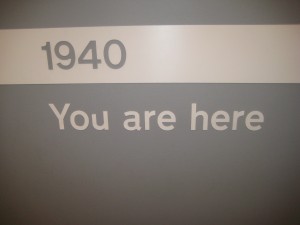
As I entered The Cabinet War Rooms and Churchill Museum I noticed a sign that appropriately read “1940 – You are here.” The War Rooms especially had the effect of transporting me back through the decades and directly into the blitz years. I let myself become immersed in the time period, trying to experience the War Rooms as they would have been experienced during the blitz. Walking through the halls and listening to the recordings of secretaries furiously punching at typewriters, phones ringing, air raid sirens screaming and the distant, guttural peal of bombs – like some Gregorian chant – , I felt as though I truly was there.
Living quarters were by no means spacious or luxurious. Winston Churchill and his staff lived in small bedrooms with small twin beds – some cots, even – and small furniture, and they cooked in a small kitchen. The fact that the Prime Minister lived and worked in a somewhat average space – though his accommodations were by no means completely Spartan – impressed me. It reminded me of how The Queen Mother rejoiced at the bombing of Buckingham palace and felt that she could now more closely connect and identify with her subjects. Churchill, in this way, was living in a similar fashion as those who elected him.
The War Rooms themselves were built underground. It consisted of several levels including a sub-basement or crawl space area. The Rooms were protected by steel-reinforced concrete up to three metres thick, depending on the area. The halls seemed labyrinthine – I’m not sure if the Rooms were laid out this way throughout the blitz, or if they were re-arranged when the museum was opened, though many of the rooms were left just as they were.
The Churchill museum was equally as interesting, though it brought up current issues as well as those from the past. One section in particular focused on Churchill’s sentiments towards the Indians. In rather “politically correct” and certainly “British” words, a placard mentioned that Churchill took a social Darwinist approach with his policies towards India, claiming that if Great Britain had not intervened, the religious factions in the country would surely turn against one another in a barbaric warfare. I was not particularly surprised by this, unfortunately, considering the problems dealing with race and ethnicity seen so frequently throughout the latter half of the 20th century. In fact, perhaps those later problems were actually rooted within the racist history of previous British policy.
Overall, the museum was very informative and interesting, especially the Cabinet War Rooms section. The ability of the exhibit to situate the visitor in the heat of the blitz renders this museum truly successful in meeting the goal that all museums should strive to achieve;reaching – and truly affecting – its audience.
Tags: Anya · Museums
The man who spoke these words has been criticized, revered, idolized, and forever memorialized in Britain and throughout the world. His contributions (and faults) are integral to history books and will remain as such so long as people study the twentieth century in any capacity. This man was Winston Churchill. His life and legacy, traced by the recently opened Churchill Museum (located in the equally significant Cabinet War Rooms), was one among many stops on today’s venture out to the city.
What a fascinating life this man led. Certainly, many know him as the Prime Minister who essentially led Britain through WWII. The years of his (first) term in office were some of his finest and most recognized moments. I’ve studied Churchill before stepping foot in the Museum (If you haven’t seen it, you must go – it’s worth every pence) and knew that he led an illustrious career in the British government throughout the early 1900s. Throughout his life he wrote books and articles, he painted, and he traveled. He went on to serve as Prime Minister once more in the 1950s but soon retired due to his declining health. The life he led was unconventional but provocative enough to grab the spotlight as one of the most influential leaders of the last century. I certainly agree with Kelley (“All Around Westminster”) that all politicians have their faults and not-so-proud moments, and Churchill is no exception. I do not and will not idolize Churchill, but, admittedly, just his persona alone demands your attention.

"Cheer up! They will forget _you_ but they will remember _me_ always."
This museum, attached to the Cabinet War Rooms, gave such a profound impression of life for government officials during the Second World War. Moreover, if Winston Churchill had to crawl through these narrow halls for meetings underground during bomb raids, one can’t even imagine what it was like to be stuck above ground (or at least above the thick slab of concrete and steel that guarded the War Rooms). As a student endlessly fascinated by culture, politics, and leadership of Britain, Europe, and the United States (few among a growing list) during the twentieth century, this museum gave me some new perspective on Britain during the war.
I feel I would be doing the Westminster Abbey and St. James Park some injustice if I failed to mention how astounded I was when I saw them. The architecture of the Abbey and the awe-inspiring space it occupies could make anyone feel small and insignificant. The tombs and busts of individuals line every wall and, to add some eerie sense to the building, every walkway. The eroded stone of tombstones embedded in the floor felt sacrilegious; take, for instance, standing on the grave of Charles Dickens, which felt powerful and odd at the same time. The hundreds of people in the Abbey had headsets stuck to their ear, which, at the time made sense. After some reflection, one could have wandered without tour guides or headsets and have had a similarly profound experience.
St. James, too, had some remarkable qualities. The most striking is it’s sheer size. A pond cuts through the middle of the park and stretches far into the distance. At one point, you couldn’t hear or see anything but the park. The people, too, add an interesting flavor to the area. No one sat in the hundreds of chairs in the space (and rightfully so – you must pay to sit down in the chairs, apparently), so they opted for lying down in the grass. Some were loud businesspeople eating their lunch, some were on a run, and others seemed dazed and confused as they wandered. It definitely attracts a variety of people, but, as already noted below in Audrey’s post “Peace out from the park,” the open gates of the park may be limiting other people given its location, among other reasons.



How did we possibly manage to fit all of this in one day?
Tags: Brandon








